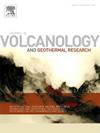来源反演和羽流上升模拟方法估算的火山灰源期特征的比较:Raikoke 2019
IF 2.3
3区 地球科学
Q2 GEOSCIENCES, MULTIDISCIPLINARY
Journal of Volcanology and Geothermal Research
Pub Date : 2025-03-04
DOI:10.1016/j.jvolgeores.2025.108304
引用次数: 0
摘要
喷发后火山灰位置和浓度的预测在很大程度上依赖于对源项特征的估计,包括大规模喷发速率、火山灰垂直分布和颗粒大小分布。这些特征可以通过几种方法提供,包括:(i)基于历史数据的预设值,(ii)近源羽流上升模型模拟,(iii)卫星检索和远程色散模型模拟的组合(称为源反演)。本研究首次对这些不同方法的源项特征进行了比较。该研究以2019年Raikoke火山喷发为研究对象,分析了距离火山口下风150公里处的火山灰云,该火山灰云代表了远端火山云中火山灰分散的有效源项。结果表明,羽流上升和震源反演方法在火山灰垂直分布上很一致,但在这一距离上的水平质量通量估计差异很大。羽流上升模型显示了靠近火山口的粗粒(直径100μm)火山灰颗粒的快速沉降和沉积,导致颗粒尺寸分布与伦敦VAAC在该范围内实际使用的预设分布相当。这些结果表明,源反演可以为估算火山灰垂直分布提供一种计算成本较低的替代方法,而不是三维羽流上升方法,并且在预设的粒径分布中,粗颗粒的近源沉降假设是相当有效的。建议进行进一步的研究,包括粒子聚集效应,以了解有效集体喷发率估计的差异。本文章由计算机程序翻译,如有差异,请以英文原文为准。

A comparison of volcanic ash source term characteristics estimated by source inversion and plume rise modelling methods: Raikoke 2019
Predictions of volcanic ash location and concentration following an eruption rely heavily on estimates of source term characteristics including mass eruption rate, vertical distribution of ash and particle size distribution. These characteristics can be provided by several methods including (i) preset values based on historical data, (ii) near-source plume rise model simulations, (iii) a combination of satellite retrievals and long-range dispersion model simulations (known as source inversion). For the first time, this study presents a comparison of source term characteristics from these different methods. The study focuses on the 2019 Raikoke eruption and analysis of the volcanic ash cloud 150 km downwind from the volcano vent, representing an effective source term for the dispersion of ash in the distal volcanic cloud. Results indicate good agreement in the vertical distribution of ash between the plume rise and source inversion methods but large differences in estimates of the horizontal mass flux at this distance. The plume rise model demonstrates the rapid sedimentation and deposition of coarse ( diameter) ash particles close to the volcano vent resulting in a particle size distribution comparable to the preset distribution used operationally by the London VAAC at this range. These results suggest that source inversion can provide a computationally cheaper alternative to the 3D plume rise method for estimating the vertical distribution of ash, and that the assumption of near-source fallout of coarse particles in the preset particle size distribution holds fairly well. Further investigations are recommended including particle aggregation effects to understand differences in estimates of the effective mass eruption rate.
求助全文
通过发布文献求助,成功后即可免费获取论文全文。
去求助
来源期刊
CiteScore
5.90
自引率
13.80%
发文量
183
审稿时长
19.7 weeks
期刊介绍:
An international research journal with focus on volcanic and geothermal processes and their impact on the environment and society.
Submission of papers covering the following aspects of volcanology and geothermal research are encouraged:
(1) Geological aspects of volcanic systems: volcano stratigraphy, structure and tectonic influence; eruptive history; evolution of volcanic landforms; eruption style and progress; dispersal patterns of lava and ash; analysis of real-time eruption observations.
(2) Geochemical and petrological aspects of volcanic rocks: magma genesis and evolution; crystallization; volatile compositions, solubility, and degassing; volcanic petrography and textural analysis.
(3) Hydrology, geochemistry and measurement of volcanic and hydrothermal fluids: volcanic gas emissions; fumaroles and springs; crater lakes; hydrothermal mineralization.
(4) Geophysical aspects of volcanic systems: physical properties of volcanic rocks and magmas; heat flow studies; volcano seismology, geodesy and remote sensing.
(5) Computational modeling and experimental simulation of magmatic and hydrothermal processes: eruption dynamics; magma transport and storage; plume dynamics and ash dispersal; lava flow dynamics; hydrothermal fluid flow; thermodynamics of aqueous fluids and melts.
(6) Volcano hazard and risk research: hazard zonation methodology, development of forecasting tools; assessment techniques for vulnerability and impact.

 求助内容:
求助内容: 应助结果提醒方式:
应助结果提醒方式:


